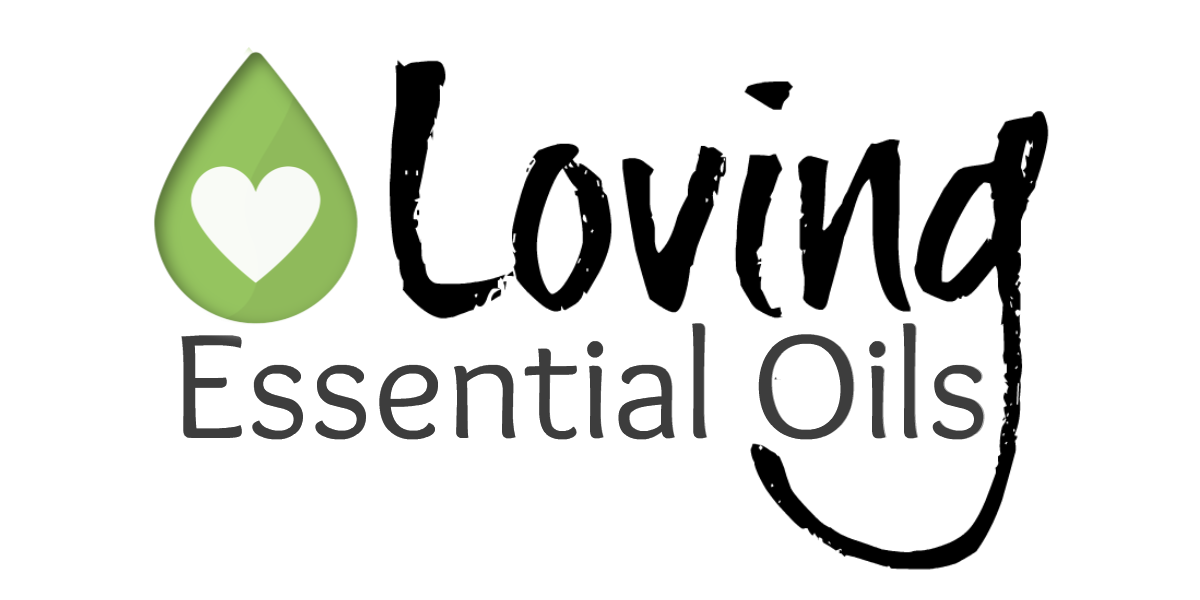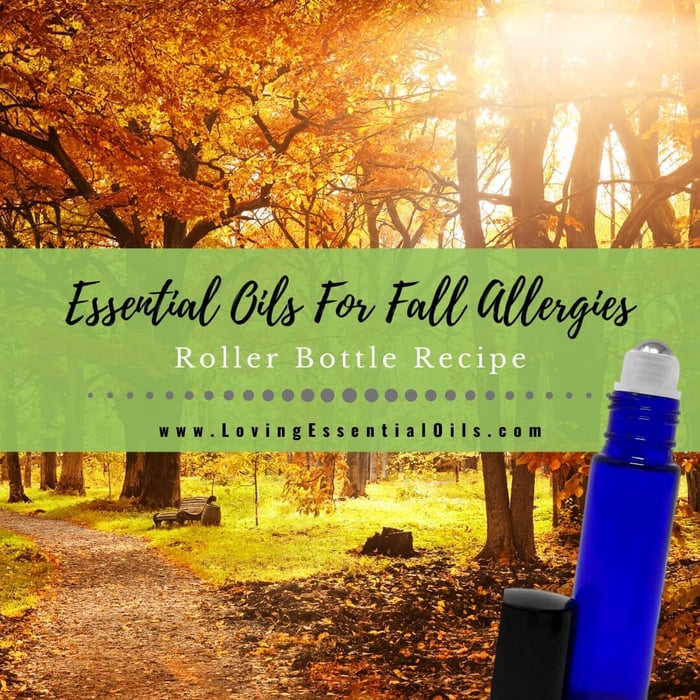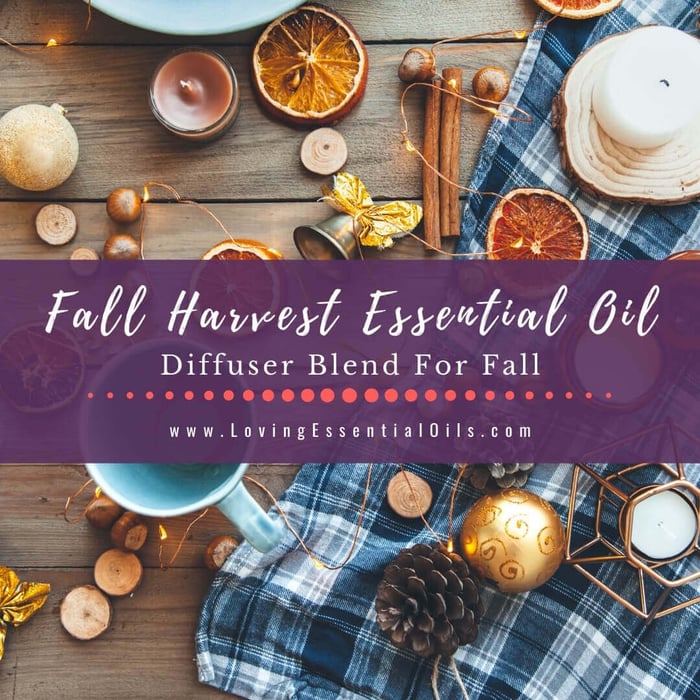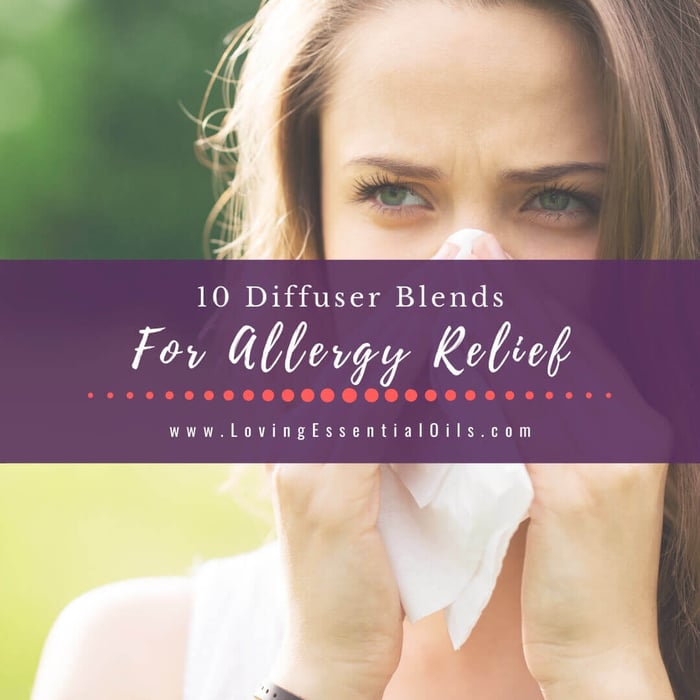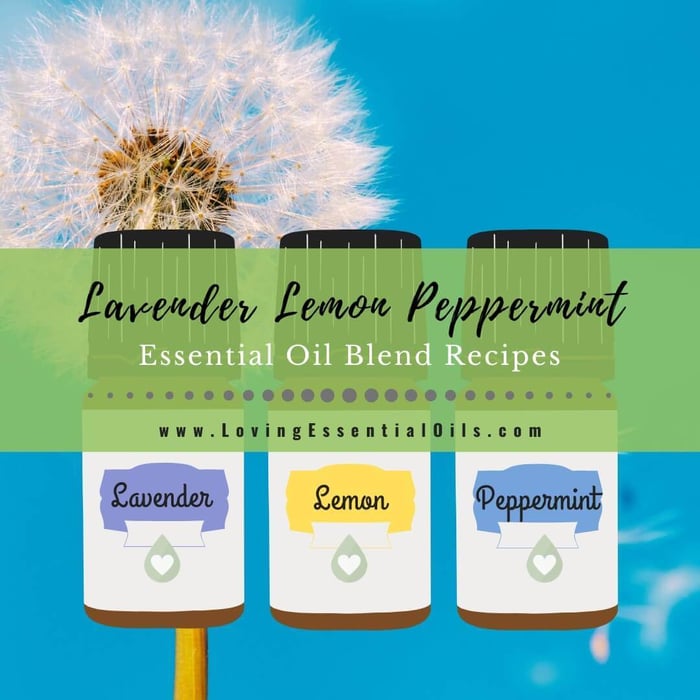Table of Contents
- Discover the Most Effective Fall Essential Oils for Seasonal Allergy Relief
- Best Essential Oils for Fall Allergies
- How Do Fall Allergens Trigger Seasonal Symptoms, and How Can Essential Oils Help?
- Fall Allergies Roller Bottle Recipe
- Free Printable: Essential Oils for Fall Allergies Roller Recipe Sheet with Labels
- More Essential Oil Blends for Fall Allergies
- What Are the Top Diffuser Blends for Autumn Congestion and Immunity?
- How to Create Natural Inhalers for Sinus and Cold Symptom Support?
- What Are Effective Chest Rub and Topical Blend Recipes for Fall Symptoms?
- Which Essential Oils Best Help Reduce Sneezing, Congestion, and Itchy Eyes?
- How Do Peppermint, Eucalyptus, and Lemon Oils Naturally Combat Fall Allergies?
- What Are the Unique Benefits of Lavender, Frankincense, and Tea Tree Oils for Allergy Relief?
- How Do Ravensara and Basil Oils Support Allergy Symptom Relief?
- How Can Essential Oils Support Mental Well-being During Fall Allergy and Cold Seasons?
- Naturally Ease Common Cold Symptoms in Fall with Essential Oils
- Which Essential Oils Are Best for Cough, Sore Throat, and Congestion?
- What Are the Antiviral and Antimicrobial Properties of Tea Tree and Ravensara Oils?
- How Do Frankincense and Eucalyptus Oils Support Respiratory Health During Colds?
- What Lifestyle Practices Complement Essential Oil Use for Fall Wellness?
- General Essential Oil Precautions
- About the Author: Jennifer Lane
- FAQs
Seasonal changes got you sniffling and sneezing? Find all-natural relief in this simple essential oil roller bottle recipe. It includes my favorite essential oils for fall allergies.
Fall is in the air, and it's time to break out your cozy sweaters, pumpkin spice lattes, and fuzzy socks. However, the colder days and weather transition also bring more allergies for many people.
This blog post will discuss how this natural remedy can alleviate allergy symptoms so you can enjoy your favorite fall activities without feeling miserable.
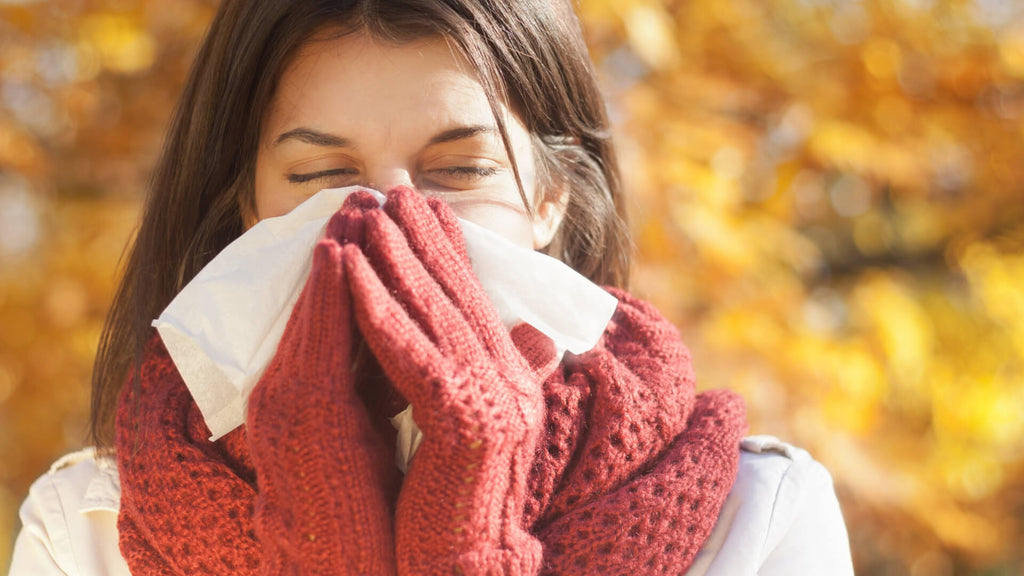
Discover the Most Effective Fall Essential Oils for Seasonal Allergy Relief
Seasonal allergies often kick in when common triggers like pollen, mold spores, or dust mites cause your immune system to overreact. Essential oils can step in with targeted anti-inflammatory, antihistamine, and decongestant benefits. They can help calm sneezing, soothe those itchy eyes, and clear congested nasal passages.
Fall Essential Oils Guide - DIY Recipes
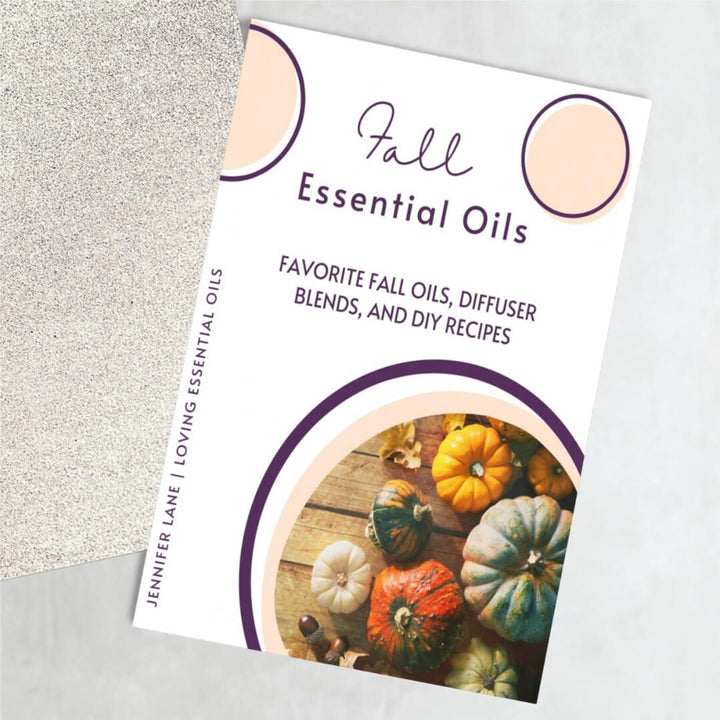
$ 2.99
Fall is here and it's the perfect time to get cozy with essential oils. Whether you're looking for something comforting or need a pick-me-up, essential oils are can help. Get our Fall Essential Oils Guide filled with ideas and recipes… Read More
Best Essential Oils for Fall Allergies
My favorite essential oils for fall allergies include lavender, peppermint, and lemon. This blend of oils can help relieve the congestion, stuffiness, itchiness, and sniffles that occur from changing seasons. The aroma is delightful as well!
Lavender Essential Oil
Lavender essential oil is an excellent natural remedy for relief from fall allergies. Inhaling the fragrance opens your sinuses and releases histamine to counteract allergy symptoms. It also soothes an irritated throat and helps with headaches caused by seasonal allergies.
Lavender is known as "nature's tranquilizer" because of its ability to promote relaxation. This oil can help lower stress levels, improve mood, increase calmness and balance, relieve anxiety and depression-related symptoms, reduce pain due to cramps or menstrual cycles…and more!
Peppermint Essential Oil
Peppermint essential oil is a great option because it has anti-inflammatory and decongestant properties, which can help alleviate symptoms of seasonal allergies. In this blog post, I will discuss how peppermint oil works, why it’s good for you in the fall, and how to use it at home without breaking your budget!
Lemon Essential Oil
Lemon essential oil can help relieve the symptoms of seasonal allergies. It could be your answer if you have allergies and are looking for a natural remedy!
Lemon oil can reduce congestion and soothe sore throats caused by seasonal allergy symptoms. It has also been shown to reduce inflammation in the body and the nasal passage, reduce congestion, and provide much-needed relief from the pesky symptoms of typical allergies.
How Do Fall Allergens Trigger Seasonal Symptoms, and How Can Essential Oils Help?
Understanding your triggers is the first step to choosing the right oils for prevention and relief. Fall allergens like ragweed, mold spores, and dust mites can activate your immune system, leading to histamine release and inflammation.
What Are Common Fall Allergens Like Ragweed, Mold Spores, and Dust Mites?
Ragweed pollen typically peaks in late summer and early fall, often causing intense sneezing and itchy eyes. Damp conditions from fallen leaves can encourage mold growth, releasing spores that can worsen nasal congestion. Dust mites tend to thrive in cooler indoor environments, potentially triggering persistent runny noses and sinus pressure.
How Do Essential Oils Target These Specific Allergens and Symptoms?
Essential oils rich in 1,8-cineole, like eucalyptus, and menthol, found in peppermint, act as natural decongestants. Oils with antihistamine properties, such as lemon and lavender, can help reduce inflammation caused by histamine. Antimicrobial oils like tea tree and ravensara can also help manage mold and dust mite populations indoors when diffused.
What Evidence Supports Using Peppermint Oil for Headache and Sinus Pressure Relief?
The menthol in Peppermint Oil activates cold-sensitive receptors, providing a natural analgesic effect that can reduce headache intensity and ease sinus pressure. Clinical studies have shown that applying peppermint oil topically can improve tension-type headache pain by up to 40%, making it a reliable natural remedy for sinus-related discomfort.
Göbel, H., et al., "Effectiveness of Oleum Menthae piperitae in tension-type headache" (1996)
Fall Allergies Roller Bottle Recipe
Roller bottles make using essential oils for fall allergies really simple. Plus, your oils will be diluted and ready to use when a specific need arises. Have all your favorite roller recipes ready when you need them!
- 4 drops Lavender Essential Oil
- 3 drops Peppermint Essential Oil
- 3 drops Lemon Essential Oil
- Jojoba Oil (or carrier oil of choice)
- 10 ml Roller Bottle
Directions:
1) Add essential oils for fall allergies to the roller bottle.
2) Fill the rest of the bottle with carrier oil, leaving space at the top for the insert.
3) Insert roller ball and place cap on. Roll the bottle between palms to blend oils together.
4) To use, apply a small amount to the back of the neck, wrists, and temples. Keep away from the eyes. Massage gently into the skin. Repeat as needed. Be sure to add a bottle label.
Dilution Level: This recipe provides approximately a 5% dilution level in a 10 ml roller bottle, based on the standard of 6 drops per 1 oz equaling a 1% dilution.
Free Printable: Essential Oils for Fall Allergies Roller Recipe Sheet with Labels
No email is required! We hope you love this free printable. Please share this page on your favorite social media sites, such as Pinterest, Twitter, Facebook, or Instagram, so others can enjoy it.
Get our printable recipe for Essential Oils for Fall Allergies!
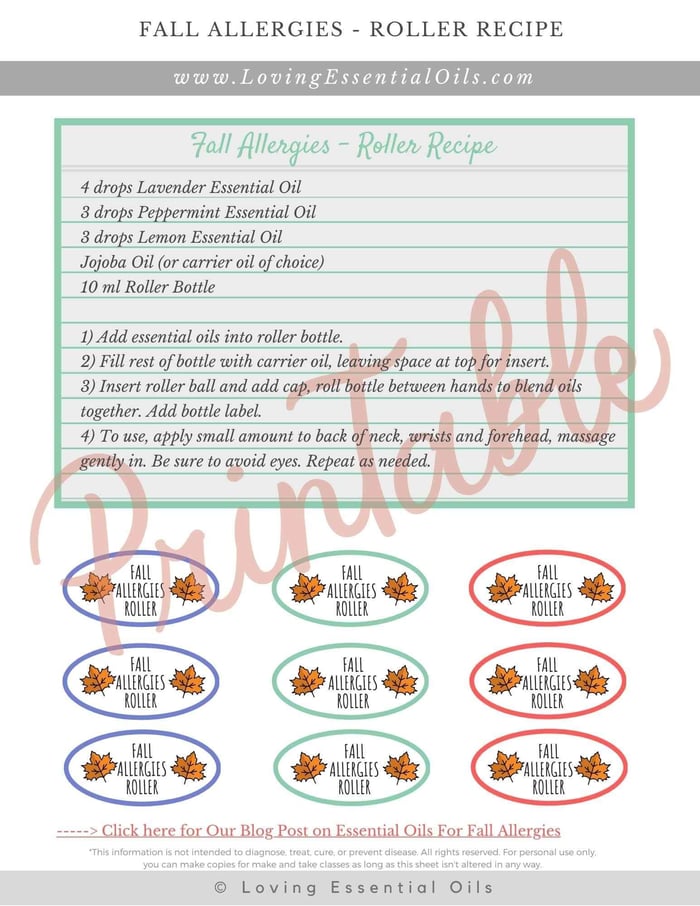
More Essential Oil Blends for Fall Allergies
Creating your own essential oil blends allows you to customize relief for your specific needs. Here are three more practical recipes, from inhalers to chest rubs.
This blend offers cooling decongestion and calming antihistamine support whenever allergy symptoms strike.
What Are the Top Diffuser Blends for Autumn Congestion and Immunity?
When fall congestion hits, try this powerful trio from Loving Essential Oils’ Fall Diffuser Blends collection:
- 3 drops Eucalyptus Oil
- 2 drops Tea Tree Oil
- 2 drops Frankincense Oil
Add these to your ultrasonic diffuser with water and run for 20–30 minutes. This combination can help reduce airborne pathogens, ease mucus buildup, and support your respiratory system.
How to Create Natural Inhalers for Sinus and Cold Symptom Support?
Assemble a portable inhaler with these essential oils for quick relief:
- 5 drops Ravensara Oil
- 5 drops Peppermint Oil
- 3 drops Lemon Oil
Saturate the cotton wick inside an inhaler tube, cap it securely, and inhale deeply whenever you experience congestion or sinus pressure. This compact remedy provides on-demand relief wherever you are.
What Are Effective Chest Rub and Topical Blend Recipes for Fall Symptoms?
For a soothing chest rub to help with colds and coughs, try this blend:
- 5 drops Eucalyptus Oil
- 4 drops Frankincense Oil
- 3 drops Lavender Oil
- 2 tablespoons carrier oil
This blend provides a safe and effective 2% dilution for topical application.
Massage this blend over your chest and upper back to help clear airways and reduce coughing fits, then relax and let the oils work their magic overnight.
Which Essential Oils Best Help Reduce Sneezing, Congestion, and Itchy Eyes?
For allergy symptoms like sneezing, congestion, and itchy eyes, reach for oils known for their decongestant and anti-inflammatory properties:
- Peppermint Oil provides a refreshing, cooling sensation that helps open up airways
- Eucalyptus Oil, rich in cineole, works to thin mucus and ease breathing
- Lemon Oil supports your lymphatic system, helping to relieve sinus pressure
- Lavender Oil gently soothes inflamed mucous membranes and calms irritation
These oils blend beautifully together, allowing you to tackle multiple symptoms at once for more comprehensive relief.
How Do Peppermint, Eucalyptus, and Lemon Oils Naturally Combat Fall Allergies?
Peppermint Oil (Mentha piperita) can help ease congestion by promoting airway dilation and may even help reduce histamine release.
Eucalyptus Oil (Eucalyptus radiata) acts as a natural expectorant, assisting in breaking down mucus and clearing your sinuses.
Lemon Oil (Citrus limon) supports your body's natural detox pathways, which can help alleviate sinus pressure and refresh your indoor air. Diffusing these oils together can maximize their decongestant, antiviral, and immune-cleansing benefits to help combat allergic rhinitis.
Silva, J., et al., "Eucalyptus essential oil: evidence for its efficacy in the treatment of respiratory tract infections" (2018)What Are the Unique Benefits of Lavender, Frankincense, and Tea Tree Oils for Allergy Relief?
Lavender Oil (Lavandula angustifolia) offers calming, anti-inflammatory relief for itchy eyes and irritated skin.
Frankincense Oil (Boswellia carterii) helps reduce inflammation in mucous membranes thanks to its boswellic acid content, while also promoting a balanced immune response.
Tea Tree Oil (Melaleuca alternifolia) provides powerful antimicrobial action that can be beneficial in managing secondary sinus infections that sometimes accompany prolonged allergy flare-ups.
How Do Ravensara and Basil Oils Support Allergy Symptom Relief?
Ravensara Oil (Ravensara aromatica) boasts antiviral and expectorant properties, helping to clear your respiratory passages when allergies make breathing difficult.
Basil Oil (Ocimum basilicum), with its eugenol and camphoraceous compounds, can help ease sinus headaches and calm a cough reflex, making it a great choice for nighttime relief.
Fall Essential Oils Guide - DIY Recipes

$ 2.99
Fall is here and it's the perfect time to get cozy with essential oils. Whether you're looking for something comforting or need a pick-me-up, essential oils are can help. Get our Fall Essential Oils Guide filled with ideas and recipes… Read More
How Can Essential Oils Support Mental Well-being During Fall Allergy and Cold Seasons?
The discomfort of seasonal changes can sometimes bring stress, fatigue, and restless nights. Aromatherapy can help restore your mental balance by promoting relaxation, improving sleep quality, and lifting your mood.
Which Oils Help Reduce Stress, Fatigue, and Promote Better Sleep?
Lavender Oil is known for its ability to relax the nervous system and enhance sleep depth.
Clary Sage Oil (Salvia sclarea) can help balance hormones and ease mood swings.
Bergamot Oil offers an uplifting citrus aroma that combats fatigue and anxiety. Diffusing these oils before bed can encourage restorative rest and build emotional resilience.
How to Incorporate Aromatherapy into a Holistic Fall Wellness Routine?
Integrate these mood-boosting oils into your evening rituals:
- Add 3 drops of Lavender and 2 drops of Clary Sage to your diffuser before bedtime
- Apply a pre-made sleep roller blend (like Lavender mixed with Jojoba oil) to your wrists and temples
- Create invigorating Citrus-mint inhalers for a midday energy boost
By combining these practices with good hydration, gentle exercise, and mindful breathing, you can foster complete seasonal wellness.
What Are User Experiences and Testimonials on Mental Health Benefits?
Many of our customers at Loving Essential Oils share that diffusing lavender and clary sage nightly has significantly reduced their fall-related anxiety and improved their sleep quality within just a week. Parents often mention that roller blends help calm restless children before bedtime, highlighting the powerful impact of aromatherapy on family well-being.
Naturally Ease Common Cold Symptoms in Fall with Essential Oils
Colds are typically caused by viral infections in the upper respiratory tract, leading to symptoms like coughs, sore throats, congestion, and fatigue. Essential oils can help by fighting viruses, supporting your immune system, and easing inflammatory responses to speed up recovery and reduce discomfort.
Which Essential Oils Are Best for Cough, Sore Throat, and Congestion?
When it comes to soothing coughs, easing sore throats, and clearing nasal passages, these oils are your go-to choices:
- Eucalyptus Oil acts as a mucolytic and offers excellent respiratory support - Check out our Eucalyptus essential oil blends.
- Tea Tree Oil provides broad-spectrum antimicrobial defense
- Frankincense Oil helps reduce bronchial inflammation and supports expectoration
- Peppermint Oil soothes sore throats and alleviates sinus pressure
Combining these oils in steam inhalations or using them in inhaler sticks can offer immediate relief for coughs and support your airways.
What Are the Antiviral and Antimicrobial Properties of Tea Tree and Ravensara Oils?
Tea Tree Oil’s active compounds, like terpinen-4-ol and 1,8-cineole, are known to penetrate viral membranes and inhibit microbial growth in lab studies.
Ravensara Oil contains methyl chavicol and limonene, which may help disrupt viral replication and boost your innate immunity. Used together, they can create a synergistic barrier against common cold viruses and potential secondary bacterial infections.
How Do Frankincense and Eucalyptus Oils Support Respiratory Health During Colds?
Frankincense Oil’s anti-inflammatory boswellic acids work to reduce swelling in the bronchial passages, while its rich aroma promotes balanced immune function.
Eucalyptus Oil helps improve the function of the cilia in your airway lining, which aids in clearing mucus and can lessen cough frequency. Whether used in a diffuser or a chest rub, these oils can help maintain clear breathing as you recover from a cold.
What Lifestyle Practices Complement Essential Oil Use for Fall Wellness?
Boost your fall wellness by combining essential oils with these healthy habits:
- Stay hydrated and incorporate anti-inflammatory foods like ginger tea
- Prioritize regular sleep and establish stress-reducing rituals
- Clean and vacuum your home frequently to minimize indoor allergens
- Use HEPA filters in air purifiers to create cleaner breathing zones
General Essential Oil Precautions
Never use essential oils undiluted in the eyes or mucous membranes. Do not take them internally unless working with a qualified practitioner. Keep out of reach from children and pets.
Use essential oils with extreme caution on children. Be sure you have researched the oil and that it is safe for kids to use.
If applying an essential oil topically (on your skin), you may perform a small patch test on an insensitive body part. Use 1-2 drops in a teaspoon of carrier oil, like jojoba oil. Read more about the essential oil patch test.
If you are pregnant, breastfeeding, epileptic, or under a doctor’s care, consult your physician. Get more information on oil essential oil safety issues.
Share On Pinterest
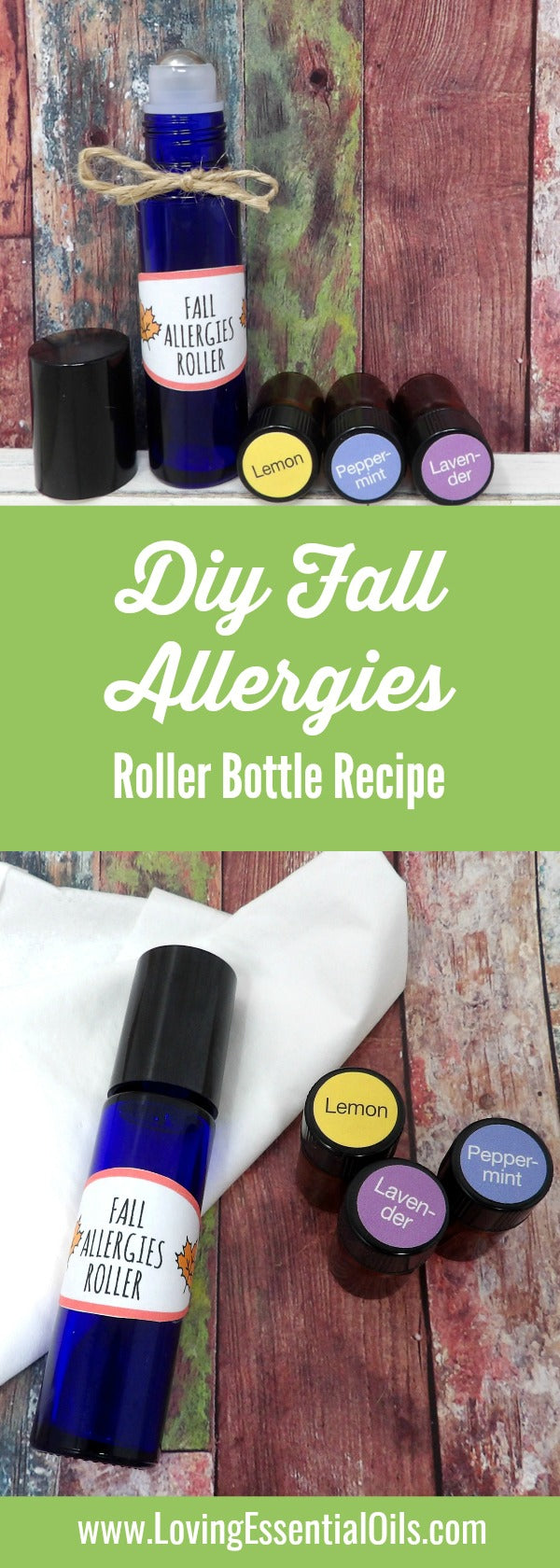
About the Author: Jennifer Lane
Autumn doesn’t have to mean endless sniffles and sleepless nights. Jennifer Lane, the passionate founder of Loving Essential Oils, understands the challenges of fall allergies firsthand. For years, she battled the seasonal sniffles, congestion, and fatigue that autumn often brings. Through research and experimentation, Jennifer discovered effective ways to use these natural remedies to soothe her own symptoms and those of her family.
Her mission is to share this invaluable knowledge, empowering others to embrace the cooler months with confidence and breathe easy, naturally.
By choosing the right essential oils and using them safely, you can transform seasonal challenges into opportunities for natural relief and mental rejuvenation. Explore our collection of roller recipes, inhalers, blends, and digital guides at Loving Essential Oils to empower your autumn wellness journey.
FAQs
Can I Use Roller Bottles with Essential Oils for Fall Allergies?
Roller bottle recipes are a great way to use essential oils for natural health and wellness, including fall allergies. All you need is a carrier oil, roller bottles, and essential oils. Once you have these ingredients, you can make all kinds of roller recipes for yourself and your family.
How to Use Diffusers, Roller Bottles, and Inhalers for Allergy and Cold Relief?
Here’s a quick look at popular application methods, the equipment you’ll need, and their main benefits to help you decide:
| Method | Equipment | Primary Benefit |
|---|---|---|
| Diffusion | Ultrasonic diffuser | Provides continuous airborne decongestion |
| Roller Bottle | 10 mL roller bottle | Offers targeted, portable topical relief |
| Inhaler Stick | Portable inhaler | Delivers on-demand respiratory support |
These methods are designed to fit various lifestyles and symptom intensities, allowing you to stay comfortable whether you’re at home or on the go.
How to Store Essential Oils Properly During Fall?
Keep your essential oils in dark glass bottles, stored away from heat and direct sunlight. Ensure the lids are tightly closed to preserve their volatile compounds. Label each bottle with the date you opened it—most oils maintain their effectiveness for 12–24 months when stored correctly.
What Are the Benefits of Steam Inhalation and Topical Application in Fall?
Steam inhalation, using hot water infused with decongestant oils like eucalyptus or peppermint, can instantly open up your airways. Topical application, using diluted blends applied to your chest and sinus areas, delivers localized anti-inflammatory effects and supports lymphatic drainage for lasting comfort.
What Precautions Should Be Taken with Essential Oil Usage for Children, Pets, and Pregnant Individuals?
- Always perform a patch test before using essential oils on skin.
- Avoid internal use of essential oils.
- Avoid highly concentrated blends for young children and pregnant women.
- Keep diffuser sessions to under 30 minutes and ensure good ventilation with fresh air.
- Research pet-safe oils and use only minimal diffusion in well-ventilated spaces.
